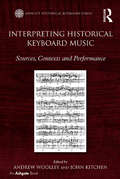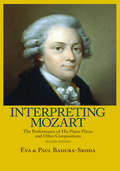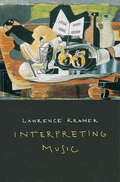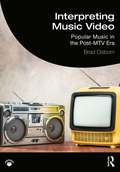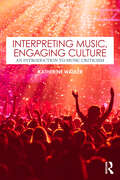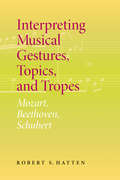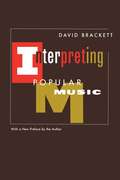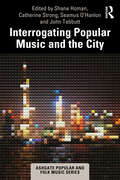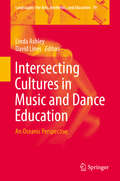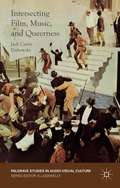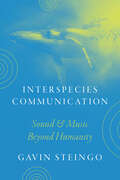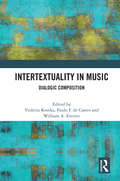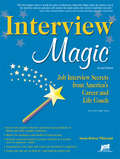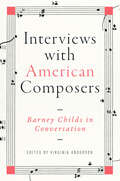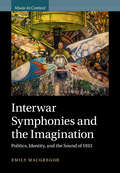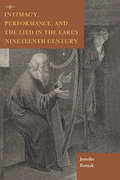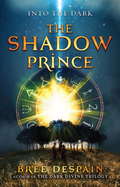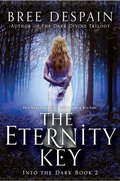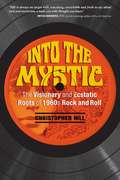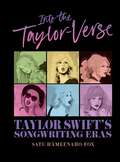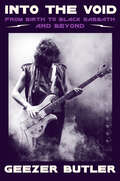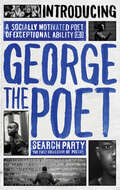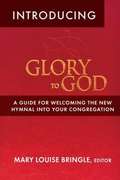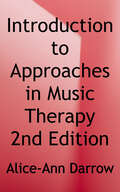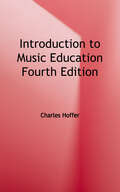- Table View
- List View
Interpreting Historical Keyboard Music: Sources, Contexts and Performance (Ashgate Historical Keyboard Series)
by Andrew Woolley John KitchenResearch in the field of keyboard studies, especially when intimately connected with issues of performance, is often concerned with the immediate working environments and practices of musicians of the past. An important pedagogical tool, the keyboard has served as the ’workbench’ of countless musicians over the centuries. In the process it has shaped the ways in which many historical musicians achieved their aspirations and went about meeting creative challenges. In recent decades interest has turned towards a contextualized understanding of creative processes in music, and keyboard studies appears well placed to contribute to the exploration of this wider concern. The nineteen essays collected here encompass the range of research in the field, bringing together contributions from performers, organologists and music historians. Questions relevant to issues of creative practice in various historical contexts, and of interpretative issues faced today, form a guiding thread. Its scope is wide-ranging, with contributions covering the mid-sixteenth to early twentieth century. It is also inclusive, encompassing the diverse range of approaches to the field of contemporary keyboard studies. Collectively the essays form a survey of the ways in which the study of keyboard performance can enrich our understanding of musical life in a given period.
Interpreting Mozart: The Performance of His Piano Pieces and Other Compositions (Da Capo Press Music Reprint Ser.)
by Eva Badura-Skoda Paul Badura-SkodaOriginally published in German as Interpreting Mozart on the Keyboard in 1957, this definitive work on the performance of Mozart's works has greatly influenced students and scholars of keyboard literature and of Mozart. Now, in a completely updated and revised edition, this book includes the last half century of scholarship on Mozart's music, addressing the elements of performance and problems that may occur in performing Mozart's works on modern instruments.
Interpreting Music
by Lawrence KramerInterpreting Music is a comprehensive essay on understanding music and performing music meaningfully--"interpreting music" in both senses of the term. Synthesizing and advancing two decades of highly influential work, Lawrence Kramer fundamentally rethinks the concepts of work, score, performance, performativity, interpretation, and meaning--even the very concept of music--while breaking down conventional wisdom and received ideas. Kramer argues that music, far from being closed to interpretation, is ideally open to it, and that musical interpretation is the paradigm of interpretation in general. The book illustrates the many dimensions of interpreting music through a series of case studies drawn from the classical repertoire, but its methods and principles carry over to other repertoires just as they carry beyond music by working through music to wider philosophical and cultural questions.
Interpreting Music Video: Popular Music in the Post-MTV Era
by Brad OsbornInterpreting Music Video introduces students to the musical, visual, and sociological aspects of music videos, enabling them to critically analyze a multimedia form with a central place in popular culture. With highly relevant examples drawn from recent music videos across many different genres, this concise and accessible book brings together tools from musical analysis, film and media studies, gender and sexuality studies, and critical race studies, requiring no previous knowledge. Exploring the multiple dimensions of music videos, this book is the perfect introduction to critical analysis for music, media studies, communications, and popular culture.
Interpreting Music, Engaging Culture: An Introduction to Music Criticism
by Katherine WalkerInterpreting Music, Engaging Culture: An Introduction to Music Criticism offers a clear, hands-on guide for emerging music critics that brings together aesthetics, critical theory, and practical music criticism in an accessible format. Over the course of the book, readers develop a vocabulary and framework for criticizing music of all kinds and for various media while learning how to connect music to its cultural, social, and political contexts.Excerpts from primary sources throughout provide a wide range of writing examples, while Chapters address the distinct challenges of describing and interpreting music for various media and in diverse formats. Along the way, the book explores questions at the core of music and its criticism, such as what constitutes a musical work and what makes a piece of music “authentic”; it also introduces critical lenses, including feminist and queer criticism, postcolonialism and critical race theory, as well as the analysis of music in consumer culture. Addressing both classical and popular music criticism, Interpreting Music, Engaging Culture is a comprehensive and lively textbook that enables students to uncover, articulate, and analyze what makes music compelling and meaningful.
Interpreting Musical Gestures, Topics, and Tropes: Mozart, Beethoven, Schubert
by Robert S. HattenRobert Hatten’s new book is a worthy successor to his Musical Meaning in Beethoven, which established him as a front-rank scholar... in questions of musical meaning.... [B]oth how he approaches musical works and what he says about them are timely and to the point. Musical scholars in both musicology and theory will find much of value here, and will find their notions of musical meaning challenged and expanded." —Patrick McCrelessThis book continues to develop the semiotic theory of musical meaning presented in Robert S. Hatten’s first book, Musical Meaning in Beethoven (IUP, 1994). In addition to expanding theories of markedness, topics, and tropes, Hatten offers a fresh contribution to the understanding of musical gestures, as grounded in biological, psychological, cultural, and music-stylistic competencies. By focusing on gestures, topics, tropes, and their interaction in the music of Mozart, Beethoven, and Schubert, Hatten demonstrates the power and elegance of synthetic structures and emergent meanings within a changing Viennese Classical style.Musical Meaning and Interpretation—Robert S. Hatten, editor
Interpreting Popular Music: With a new preface by the author
by David BrackettThere is a well-developed vocabulary for discussing classical music, but when it comes to popular music, how do we analyze its effects and its meaning? David Brackett draws from the disciplines of cultural studies and music theory to demonstrate how listeners form opinions about popular songs, and how they come to attribute a rich variety of meanings to them. Exploring several genres of popular music through recordings made by Billie Holiday, Bing Crosby, Hank Williams, James Brown, and Elvis Costello, Brackett develops a set of tools for looking at both the formal and cultural dimensions of popular music of all kinds.
Interrogating Popular Music and the City (ISSN)
by Catherine Strong Shane Homan Seamus O'Hanlon John TebbuttHow does popular music influence the culture and reputation of a city, and what does a city do to popular music? Interrogating Popular Music and the City examines the ways in which urban environments and music cultures intersect in various locales around the globe. Music and cities have been partners in an often clumsy, sometimes accidental but always exciting dance. Heritage and immigration, noise and art, policy and politics are some of the topics that are addressed in this critical examination of relationships between cities and music. The book draws upon an international array of researchers, encompassing hip hop in Beijing; the city favelas of Brazil; from Melbourne bars to European parliaments; to heritage and tourism debates in Salzburg and Manchester. In doing so, it interrogates the different agendas of audiences, musicians and policy-makers in distinct urban settings.
Intersecting Cultures in Music and Dance Education
by David Lines Linda AshleyThis volume looks forward and re-examines present day education and pedagogical practices in music and dance in the diverse cultural environments found in Oceania. The book also identifies a key issue of how teachers face the prospect of taking a reflexive view of their own cultural legacy in music and dance education as they work from and alongside different cultural worldviews. This key issue, amongst other debates that arise, positions Intersecting Cultures as an innovative text that fills a gap in the current market with highly appropriate and fresh ideas from primary sources. The book offers commentaries that underpin and inform current pedagogy and bigger picture policy for the performing arts in education in Oceania, and in parallel ways in other countries.
Intersecting Film, Music, and Queerness (Palgrave Studies in Audio-Visual Culture)
by Jack DubowskyIntersecting Film, Music, and Queerness uses musicology and queer theory to uncover meaning and message in canonical American cinema. This study considers how queer readings are reinforced or nuanced through analysis of musical score. Taking a broad approach to queerness that questions heteronormative and homonormative patriarchal structures, binary relationships, gender assumptions and anxieties, this book challenges existing interpretations of what is progressive and what is retrogressive in cinema. Examined films include Bride of Frankenstein, Louisiana Story, Rudolph the Red-Nosed Reindeer, Blazing Saddles, Edward Scissorhands, Brokeback Mountain, Boys Don't Cry, Transamerica, Thelma & Louise, Go Fish and The Living End, with special attention given to films that subvert or complicate genre. Music is analyzed with concern for composition, intertextual references, absolute musical structures, song lyrics, recording, arrangement, and performance issues. This multidisciplinary work, featuring groundbreaking research, analysis, and theory, offers new close readings and a model for future scholarship
Interspecies Communication: Sound and Music beyond Humanity
by Gavin SteingoA surprising study reveals a plethora of attempts to communicate with non-humans in the modern era. In Interspecies Communication, music scholar Gavin Steingo examines significant cases of attempted communication beyond the human—cases in which the dualistic relationship of human to non-human is dramatically challenged. From singing whales to Sun Ra to searching for alien life, Steingo charts the many ways we have attempted to think about, and indeed to reach, beings that are very unlike ourselves. Steingo focuses on the second half of the twentieth century, when scientists developed new ways of listening to oceans and cosmic space—two realms previously inaccessible to the senses and to empirical investigation. As quintessential frontiers of the postwar period, the outer space of the cosmos and the inner space of oceans were conceptualized as parallel realities, laid bare by newly technologized “ears.” Deeply engaging, Interspecies Communication explores our attempts to cross the border between the human and non-human, to connect with non-humans in the depths of the oceans, the far reaches of the universe, or right under our own noses.
Intertextuality in Music: Dialogic Composition
by Violetta KostkaThe concept of intertextuality – namely, the meaning generated by interrelations between different texts – was coined in the 1960s among literary theorists and has been widely applied since then to many other disciplines, including music. Intertextuality in Music: Dialogic Composition provides a systematic investigation of musical intertextuality not only as a general principle of musical creativity but also as a diverse set of devices and techniques that have been consciously developed and applied by many composers in the pursuit of various artistic and aesthetic goals. Intertextual techniques, as this collection reveals, have borne a wide range of results, such as parody, paraphrase, collage and dialogues with and between the past and present. In the age of sampling and remix culture, the very notion of intertextuality seems to have gained increased momentum and visibility, even though the principle of creating new music on the basis of pre-existing music has a long history both inside and outside the Western tradition. The book provides a general survey of musical intertextuality, with a special focus on music from the second half of the twentieth century, but also including examples ranging from the nineteenth century to the second decade of the twenty-first century. The volume is intended to inspire and stimulate new work in intertextual studies in music.
Interview Magic
by Susan Britton WhitcombFuture-proof your career as you learn to provide value to employers, create a memorable career brand, quadruple your interview opportunities, tap into the most overlooked interview "must," demonstrate your ability to do the job, and bottom-line the return-on-investment employers will receive for hiring you
Interviews with American Composers: Barney Childs in Conversation (Music in American Life)
by Barney ChildsIn 1972-73, Barney Childs embarked on an ambitious attempt to survey the landscape of new American concert music. He recorded freewheeling conversations with fellow composers, most of them under forty, all of them important but most not yet famous. Though unable to publish the interviews in his lifetime, Childs had gathered invaluable dialogues with the likes of Robert Ashley, Olly Wilson, Harold Budd, Christian Wolff, and others. Virginia Anderson edits the first published collection of these conversations. She pairs each interview with a contextual essay by a contemporary expert that shows how the composer's discussion with Childs fits into his life and work. Together, the interviewees cover a broad range of ideas and concerns around topics like education, notation, developments in electronic music, changing demands on performers, and tonal music. Innovative and revealing, Interviews with American Composers is an artistic and historical snapshot of American music at an important crossroads.
Interwar Symphonies and the Imagination: Politics, Identity, and the Sound of 1933 (Music in Context)
by Emily MacGregorThe symphony has long been entangled with ideas of self and value. Though standard historical accounts suggest that composers' interest in the symphony was almost extinguished in the early 1930s, this book makes plain the genre's continued cultural dominance, and argues that the symphony can illuminate issues around space/geography, race, and postcolonialism in Germany, France, Mexico, and the United States. Focusing on a number of symphonies composed or premiered in 1933, this book recreates some of the cultural and political landscapes of an uncertain historical moment-a year when Hitler took power in Germany, and the Great Depression reached its peak in the United States. Interwar Symphonies and the Imagination asks what North American and European symphonies from the early 1930s can tell us about how people imagined selfhood during a period of international insecurity and political upheaval, of expansionist and colonial fantasies, scientised racism, and emergent fascism.
Intimacy, Performance, and the Lied in the Early Nineteenth Century (Historical Performance)
by Jennifer RonyakThe German lied, or art song, is considered one of the most intimate of all musical genres—often focused on the poetic speaker’s inner world and best suited for private and semi-private performance in the home or salon. Yet, problematically, any sense of inwardness in lieder depends on outward expression through performance. With this paradox at its heart, Intimacy, Performance, and the Lied in the Early Nineteenth Century explores the relationships between early nineteenth-century theories of the inward self, the performance practices surrounding inward lyric poetry and song, and the larger conventions determining the place of intimate poetry and song in the public concert hall. Jennifer Ronyak studies the cultural practices surrounding lieder performances in northern and central Germany in the first quarter of the nineteenth century, demonstrating how presentations of lieder during the formative years of the genre put pressure on their sense of interiority. She examines how musicians responded to public concern that outward expression would leave the interiority of the poet, the song, or the performer unguarded and susceptible to danger. Through this rich performative paradox Ronyak reveals how a song maintains its powerful intimacy even during its inherently public performance.
Into the Dark Book #1: The Shadow Prince
by Bree DespainHaden Lord, the disgraced prince of the Underrealm, has been sent to the mortal world to entice a girl into returning with him to the land of the dead. Posing as a student at Olympus Hills High--a haven for children of the rich and famous--Haden must single out the one girl rumored to be able to restore immortality to his race. Daphne Raines has dreams much bigger than her tiny southern Utah town, so when her rock star dad suddenly reappears, offering her full tuition to Olympus Hills High's prestigious music program, she sees an opportunity to catch the break she needs to make it as a singer. But upon moving into her estranged father's mansion in California, and attending her glamorous new school, Daphne soon realizes she isn't the only student in Olympus who doesn't quite belong. Haden and Daphne--destined for each other--know nothing of the true stakes their fated courtship entails. As war between the gods brews, the teenagers' lives collide. But Daphne won't be wooed easily and when it seems their prophesied link could happen, Haden realizes something he never intended--he's fallen in love. Now to save themselves, Haden and Daphne must rewrite their destinies. But as their destinies change, so do the fates of both their worlds. A pulsating romance of epic proportions, Bree Despain's The Shadow Prince will leave her fans breathless for the next book in the Into The Dark series.
Into the Dark Book #2: The Eternity Key
by Bree DespainFan-favorite author Bree Despain continues her modern-day romance trilogy inspired by the Greek myth of Persephone and Hades with this second book in her Into the Dark series. Haden Lord, the disgraced Prince of the Underrealm, has chosen love over honor and will do everything in his power to protect Daphne Raines, the human girl he was supposed to bring to the Underrealm. Haden's choice is put to the test as the Skylords and a figure from his past arrive in Olympus Hills with a plan that could destroy all of the realms. Embracing her destiny as the Cypher, Daphne begins to understand the immense power of her musical ability to control the elements, but she must come to terms with her feelings for Haden and what she must sacrifice in order to protect him and her friends. Believing the Key of Hades is the only thing that can stop the Underrealm Court from releasing the monstrous Keres on the mortal world, Haden, Daphne, and their friends set out to find the Key before Persephone's Gate opens again on the spring equinox.
Into the Mystic: The Visionary and Ecstatic Roots of 1960s Rock and Roll
by Christopher HillExplores the visionary, mystical, and ecstatic traditions that influenced the music of the 1960s • Examines the visionary, spiritual, and mystical influences on the Grateful Dead, the Beatles, the Rolling Stones, Bob Dylan, Van Morrison, the Incredible String Band, the Left Banke, Lou Reed and the Velvet Underground, and others • Shows how the British Invasion acted as the “detonator” to explode visionary music into the mainstream • Explains how 1960s rock and roll music transformed consciousness on both the individual and collective levels The 1960s were a time of huge transformation, sustained and amplified by the music of that era: Rock and Roll. During the 19th and 20th centuries visionary and esoteric spiritual traditions influenced first literature, then film. In the 1960s they entered the realm of popular music, catalyzing the ecstatic experiences that empowered a generation. Exploring how 1960s rock and roll music became a school of visionary art, Christopher Hill shows how music raised consciousness on both the individual and collective levels to bring about a transformation of the planet. The author traces how rock and roll rose from the sacred music of the African Diaspora, harnessing its ecstatic power for evoking spiritual experiences through music. He shows how the British Invasion, beginning with the Beatles in the early 1960s, acted as the “detonator” to explode visionary music into the mainstream. He explains how 60s rock and roll made a direct appeal to the imaginations of young people, giving them a larger set of reference points around which to understand life. Exploring the sources 1960s musicians drew upon to evoke the initiatory experience, he reveals the influence of European folk traditions, medieval Troubadours, and a lost American history of ecstatic politics and shows how a revival of the ancient use of psychedelic substances was the strongest agent of change, causing the ecstatic, mythic, and sacred to enter the consciousness of a generation. The author examines the mythic narratives that underscored the work of the Grateful Dead, the French symbolist poets who inspired Bob Dylan, the hallucinatory England of the Beatles’ Sgt. Pepper, the tale of the Rolling Stones and the Lord of Misrule, Van Morrison’s astral journeys, and the dark mysticism of Lou Reed and the Velvet Underground. Evoking the visionary and apocalyptic atmosphere in which the music of the 1960s was received, the author helps each of us to better understand this transformative era and its mystical roots.
Into the Taylor-Verse: Taylor Swift's Songwriting Eras
by Satu Hämeenaho-FoxA beautifully illustrated, comprehensive collectible for Swifties everywhere that offers an overview of Taylor Swift&’s life and work, including hidden references for fans to discover in a stunning, giftable package.Into the Taylor-Verse is an inventive, deeply detailed appreciation of Taylor Swift&’s songwriting prowess, her incomparable live performances, and the themes of adolescence and adulthood she&’s detailed so lovingly throughout the different eras of her career from her Fearless to Midnights. This book explores her prolific discography, as well as her worldwide tours, her phoenix-like rise from the ashes to reclaim her music publishing rights, and most importantly of all, her Swifties. In the way that Taylor&’s music helps fans to understand their own emotional response to heartbreak and first love, this book seeks to help fans understand why Taylor&’s music affects them more than any other artist. The story told through her work is the universal story of growing from a girl into a woman, the joy, heartbreak, demoralization, and finally, regrowth and maturity that every fan can relate to no matter their age. This book emulates the joy of Taylor&’s music with creative sidebar content, such as a playlist of her songs that are NOT about boys, an all-important timeline of her hairstyles, biographies of her cats, a deep-dive into the significance of the number thirteen, and so much more. Into the Taylor-Verse is a must-have primer on Taylor for any new Swiftie, telling the stories behind her songs and guiding them to listen more deeply to her extensive back catalogue, while also being a lush examination of the meaning behind the songs that are so important to readers who are already dedicated fans.
Into the Void: From Birth to Black Sabbath—And Beyond
by Geezer ButlerA rollicking, effusive, and candid memoir by the heavy metal musician and founding member of Black Sabbath, covering his years as the band’s bassist and main lyricist through his later-career projects, and detailing how one of rock’s most influential bands formed and prevailed. With over 70 million records sold, Black Sabbath, dubbed by Rolling Stone “the Beatles of heavy metal,” helped create the genre itself, with their distinctive heavy riffs, tuned down guitars, and apocalyptic lyrics. Bassist and primary lyricist Geezer Butler played a gigantic part in the band’s renown, from suggesting the band name to using his fascination with horror, religion, and the occult to compose the lyrics and build the foundation of heavy metal as we know it.In Into the Void, Butler tells his side of the story, from the band’s beginnings as a scrappy blues quartet in Birmingham through the struggles leading to the many well-documented lineup changes while touring around London’s gritty clubs (Eric Clapton, Jimi Hendrix, Frank Zappa, and The Who makes notable appearances!), and the band’s important later years. He writes honestly of his childhood in a working-class family of seven in Luftwaffe-battered Birmingham, his almost-life as an accountant, and how his disillusionment with organized religion and class systems would spawn the lyrics and artistic themes that would resonate so powerfully with fans around the world.Into the Void reveals the softer side of the heavy metal legend and the formation of one of rock’s most exciting bands, while holding nothing back. Like Geezer’s bass lines, it is both original, dramatic, and forever surprising.
Introducing George The Poet: Search Party: A Collection of Poems
by George the Poet‘The title is Search Party – the idea being that we’re all out here looking for something, and my poems are my way of finding myself.’ A young black poet blending spoken word and rap; an inner city upbringing with a Cambridge education; a social consciousness with a satirical wit and infectious rhythm – George The Poet is the voice of a new generation.Search Party is a thought-provoking and deeply autobiographical collection. From the overtly political ‘Go Home’ to the deeply personal ‘Full-time’; the narrative poems that offer vivid and unapologetic snapshots of inner-city life, such as ‘His Mistakes’, ‘Believer’ and the anthemic ‘My City’; to the provocative social commentary in ‘Lazy Dog’ and ‘YOLO’; to the inspiring, idea-driven pieces such as ‘The Power of Collaboration’ and ‘School Blues’, George takes poetry into new territories and to new audiences, offering a different way to talk about the things that matter, to explore his own experience and ideas, and encourage others explore theirs.George The Poet’s mesmerising and unforgettable live performances have earned him critical acclaim. From sell-out headline gigs and YouTube hits, to recording his own music, and now his first collection of poetry, George uses his work to speak truth to power and challenge our preconceived ideas about the society we’re living in.Whether you’re searching for yourself, for answers, for change – join the search party.
Introducing Glory to God
by Mary Louise BringleA hymnal is a vital resource to a church. It teaches every congregant about the faith and what your church believes. This collection offers a useful guide to the new Glory to God hymnal. For those who have already adopted Glory to God, this book will inform congregants all about their new resource. For those still deciding, it provides the information needed to make that determination. Ten essays explore why a new hymnal was produced; the challenges of creating a new hymnal; the theology, liturgy, language, and musical genres in Glory to God; and ideas for introducing Glory to God to your church. Two appendices offer fifteen essential facts about Glory to God and suggestions for what to do with old hymnals replaced by Glory to God.
Introduction to Approaches in Music Thearpy
by Alice-Ann DarrowThe intent of all approaches is to stimulate positive changes in clients through music, although some approaches emphasize changes in specific areas of human functioning: cognitive, physical, psychological, or social. <p><p>All of the approaches depend on the appeal and influence of music to bring about changes in clients, all of the approaches provide valid avenues for the therapeutic work, and all of the approaches require training to be used effectively. The differences in approaches are suited to the diversity of practicing clinicians and the clients they serve. <p><p>The book is organized into three major sections: Approaches Adapted from Music Education, Psychotherapeutic Approaches to Music Therapy, and Medical Approaches to Music Therapy. The organization of the chapters is similar. Chapters begin with an overview of a specific approach to music therapy. Also included in each chapter is the history or background of the approach, description of the approach including philosophical orientation, clinical applications of the approach, related research, summary or conclusions, and suggestions for further reading. <p><p>Written for entering undergraduate or graduate students in music therapy, Introduction to Approaches in Music Therapy, presents the major approaches to music therapy used today.
Introduction to Music Education
by Charles HofferThe streamlined Fourth Edition of this widely adopted text introduces prospective school music teachers to the profession of music education by one of the field's respected senior practitioners. In a warm, approachable style, Hoffer presents a working repertoire of concepts and general information, gets readers thinking about music teaching, and encourages them to examine themselves in terms of their future roles as educators in the field.Introduction to Music Education, 4/E provides a comprehensive, straightforward overview of the field, including its opportunities and its challenges. The text is written for a general music education course that precedes methods courses in which prospective teachers learn techniques for teaching various aspects of music. In addition to Hoffer's uncluttered discussions of the nature of teaching, teachers, and music, useful chapter components such as questions for discussion and projects are included.
